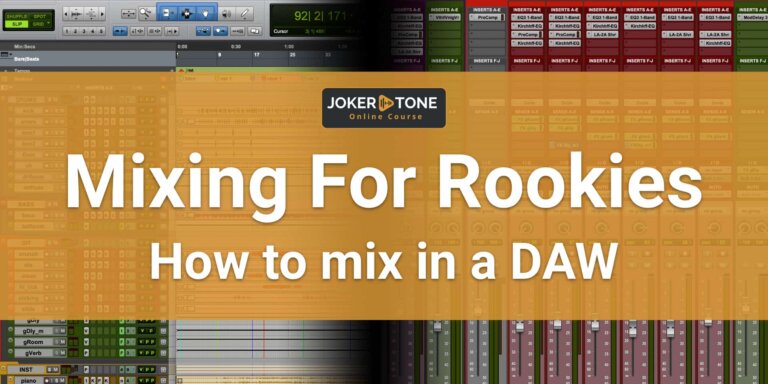Don’t release a song without the check of your final mix
Your new song is almost ready for release. The recordings are finished, the mix has been completed perfectly, and now you’ve just received the final master version of your song from your mastering engineer. Or you’ve mastered it yourself and before your music can be released, you need to check the final mix to ensure everything is perfect.
How do you make sure that you don’t miss anything during the final check of the master version and that you end up releasing a well-rounded sound?
A structured and documented procedure helps you to quickly identify problems and get to the final sound without getting lost in endless revisions.
Many things are simply published quickly without being checked. Often these releases don’t reach beyond “potential” status, although this can be overcome with a little work and, above all, feedback and testing.
We find ourselves walking a tightrope between “I’ll never finish because I can always do better” and “just get it out there, it’ll be enough, and it won’t get any better anyway”.
Finishing a song is not that easy. But once you have completed the production stages of “mixing (& mastering)”, it only needs to check the final mix and possibly a minor adjustment for the release. And considering all the groundwork you’ve done to get to this point, you should approach this last step with the same vigor and conviction.
Overview
To check the final mix, it doesn’t matter whether you have asked a mastering engineer to create the master version or whether you have completed this final step yourself. So you should have 1 or 2 people besides yourself and the mastering engineer who will check your song or the master version free of emotion or other bias.
These trustworthy people must be able to give you their honest and well-founded opinions. However, it is important to understand at this point that it is more about an analytical evaluation and not an emotional impact of the song on the listener. With this last step, you ensure that the final decisions from the mixing and mastering process are consistent with the song.
Choosing the right pre-listeners to check the final mix
People who naturally know about the subject are helpful.
- Musician friends or good friends who you know enjoy listening to music from your genre.
- Ask work colleagues with whom you get on well and who also have a certain understanding of music.
But since you’re not creating music for other people with an understanding of music and production, people who can simply give you their honest but constructive opinions are significant:
- Close friends who can be open and honest with you
- Family members who will give you neutral answers to your questions.
There are also numerous Facebook groups where you can get feedback on your songs. However, you should pay close attention to how you ask for feedback (I will go into this in more detail in the following points). On the other hand, you should be aware of whom you want to receive feedback from and who you may receive it from unintentionally.
You could also get another opinion from another mastering engineer if you can be sure they are not just trying to sell you a “better” performance.
Of course, you should never disregard your opinion and any bandmates you may have. This opinion should always carry the most weight when you check the final mix.
The requirements for the assessment
How do you ensure that everyone has the same conditions when they check the final mix?
You specify them clearly and unambiguously:
- All pre-listeners receive the same files (wav or MP3) in the same resolution.
- All “testers” should be familiar with the genre in some way.
- All interviewees should be able to check the song in the same listening situations and there are several possibilities here: In-ear headphones, boom headphones, laptop speakers, car sound system, stereo system if necessary, hi-fi system, studio speakers, TV speakers. (Not every test listener has to go through all possible listening situations, but you should determine in advance which ones should be used in any case).
- Everyone should also be able to hear your chosen reference song (if one has been selected in advance) so that any mixing decisions can be understood directly.
Define evaluation form & objectives
To ensure that all assessors can give you specific answers, create a standardized assessment system with specific questions. This way, you can be sure that everyone follows the same criteria, and that you receive specific answers that you can evaluate quickly and efficiently. Furthermore, clearly state the goal. Your song should come across equally well on all media. Everyone knows that the laptop speakers offer less bass and detail than the hi-fi system.
But if several people think that there are massive problems with some frequencies on the laptop, then this is a good indication for you and your mastering engineer to check again. It may be necessary to make additional refinements here. However, you should always be aware of who is providing you with what information. Not all of your listeners like to make analytical decisions when they check the final mix and tend to evaluate things emotionally. This is completely normal, but you should always bear this in mind.
The assessment criteria
Some countless points and variants can be listed as a basis for assessment. You have to make sure that it remains a feasible task for your examining listeners. Remember, as soon as you have two or three listening systems, the possible entries and checks multiply. When you receive the evaluation at the end, it should also be a realistic goal for you to be able to evaluate this information without too much effort and draw your conclusions from it.
I would also recommend that you not only specify the question for the evaluation but also answer options with gradations such as:
- Clearly too quiet
- Too quiet
- Just right
- A little too loud
- Clearly too loud
If you ask someone who is unable to express their feelings in concrete terms, they only need to put a cross here, and you will receive a clear tendency from the test listener about a criterion and the chosen listening medium.
Different approaches to check the final mix
1) General aspects
You ask your test listeners about the more general impression and refer to general characteristics:
- Bass range (from “clearly too little” to “clearly too powerful”)
- Mid-range (from “clearly too little” to “clearly too sharp”)
- Treble range (from “clearly too dull” to “clearly too harsh”)
Note: Depending on whom you ask, certain people may find it difficult to define where the difference lies for them. Most people can distinguish very well between bass and treble. The mid-range is somewhat more difficult to define for some.
2) Specific query on song parts
- Intro (from “clearly too quiet” to “clearly too loud”)
- Verse (from “clearly too quiet” to “clearly too loud”)
- Refrain (from “clearly too quiet” to “clearly too loud”)
- Bridge (from “clearly too quiet” to “clearly too loud”)
It must be recognizable to the listener at which points a change between the respective parts takes place. When does the verse end, and where does the chorus begin? If this is not clear — always remember, your listener may be hearing the song for the first time, while you may have heard it well over 100 times in the creation process — you can write down minutes:seconds information on where and when a part begins and ends.
3) Specific query for individual vocal/instrument parts
- Drums (explicitly bass drum, snare, and cymbals)
- bass
- Guitar parts (rhythm, lead, and solo)
- Other instruments such as piano, strings, or wind instruments
- lead vocals
- Backing vocals
In general, the question of “too loud/too quiet” fits very well here, but also how they sit in the song. In other words, too far forward or too far back, as well as too much or too little space/reverb.
The listener should tell you how they feel, and what stands out for them, both positively and negatively after the check the final mix. The listener does not have to provide you with any suggestions for a solution, as this then falls back into your area of responsibility. If you get the result that the voice cannot come out itself too well in the chorus, then you need to check which solution is the best. Whether you can make it louder, bring it forward a little by intervening in specific frequencies, or even improve the listening experience by pulling back all the other tracks.
4) Further tips for the listener
- Listen in mono if this is possible. Does the song behave in the same way as in stereo, or is something missing or overlaid by other things?
- Listen in loud, quiet, and normal volume. Very different perceptions can occur here, and some impressions can be relativized from time to time.
All these criteria should be checked on the different systems.
Of course, you should also carry out this test procedure yourself to create a starting point. This will also give you a direct impression of how much time such a test takes, including answering the questions. You will certainly have an easier time if it only takes you a few minutes to answer the questions, thanks to your good preparation and creation of the answer options for the ratings.
Additional information for people who are not involved in the music project:
Whether on paper or in digital form, you should make sure that someone receives all the necessary information about your project and that you can later identify who provided the answers. You may have further questions or want to archive the answers.
- Band name
- Album name
- Song name
- Submission date of the check
- Name of the checker
Your assessment and evaluation
Once you have all the answers back from the test listeners, you will certainly receive useful information from them that you may not have noticed yourself. You now have a well-structured collection that you can compare and process quickly and easily.
Of course, the final decision is always up to you or everyone involved in the recording, but now you can talk to the mastering engineer or make the final corrections yourself.
You can be sure that every trusted mix & mastering engineer will be happy to make the changes for you if they receive such structured and constructive comments. It will make their job much easier, and you will reach your goal much faster — your perfect sound for the release of your music.
Conclusion on how to check the final mix
Plan time for collecting feedback before the release. Choose the people who give you feedback wisely and give them a clear process of how and where to judge your song so that you get informed answers for comparison.
Don’t put your opinion and views above theirs if they all point out a problem. However, if all test listeners have different opinions, go with your gut feeling or the opinion within the band community.
Feedback
How do you make sure you check your mastered version before you release it? Do you need feedback on a song but don’t know how to ask? If you’re from a rock and pop background, feel free to contact me for feedback on your song. Please use the contact form
Niels from Joker Tone Course




